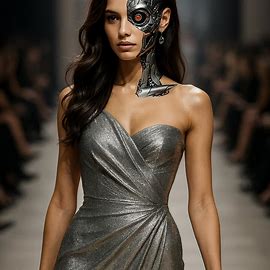Towards the end of July, the BBC reported:
“In August’s print edition of Vogue, a Guess advert features a flawless blonde model showing off a striped maxi dress and a floral playsuit from the brand’s summer collection.
In small print in one corner, the ad reveals that she was created using AI.”
Artificial intelligence is reshaping the fashion industry. Rather than hiring models, stylists, photographers, and makeup artists for traditional shoots, fashion houses can now generate photorealistic AI fashion models wearing digital garments. The allure is obvious: cost efficiency, creative control, and the ability to showcase garments in limitless scenarios. But while the technology can dazzle, legal issues can frazzle a business.

Data protection
A primary concern is whether a particular AI fashion model is based, directly or indirectly, on an identifiable individual. If an AI model is trained using real images of human models, influencers, or members of the public, then UK GDPR and the Data Protection Act 2018 may be engaged.
With reference to this, the first issue to be considered is that of biometric data. This is because an individual’s face, body shape, or other features constitute personal data. If a likeness is recognisable, its use without consent could amount to unlawful processing.
The issue of deepfakes is not confined to the BBC’s The Capture. Even if an AI model is ‘fictional,’ if it resembles a real celebrity or model, claims of misappropriation or infringement of image rights may follow. While the UK lacks a standalone image right, individuals may rely on other doctrines (such as passing off) to protect against unauthorised use of their persona. Using deepfakes may also be considered fraudulent misrepresentation or even criminal fraud.
Fashion houses should not simply proceed to use AI. Instead, they will need to ensure that training datasets are properly licensed and that subjects have consented to their use. Otherwise, regulators could take the view that there has been a breach of data protection law.
Copyright
Using AI-generated fashion imagery also gives rise to a number of copyright issues.
A fashion photoshoot typically produces ‘artistic works’ (photographs) or ‘films’ (moving images) for the purpose of copyright law. In such cases, the human photographer or videographer is the author (and the first owner of copyright, unless they are employed, in which case it will be the employer). But with AI imagery, there may be no human author in the traditional sense.
It is the case that under UK copyright law that in the case of ‘computer-generated works,’ the author is the person who undertakes the arrangements necessary for creation. This may vest copyright in the fashion house commissioning the images. However, in the AI context, this issue has not yet been tested in the Courts.
What is also the case is that if an AI system produces an image that is substantially similar to a pre-existing photograph or artwork used in its training data, copyright infringement may arise. Fashion houses relying on third-party AI tools will need strong contractual warranties to mitigate this risk.
But, even if copyright subsists in AI imagery, questions remain about enforceability, especially if international campaigns are launched in countries less willing to recognise copyright in AI-generated works.
Passing off
Perhaps the most potent weapon for UK celebrities and models concerned about AI lookalikes is passing off. This was shown some years ago in a fight between Rihanna and the then owner of Topshop.
In this case, the Court of Appeal upheld Rihanna’s claim that Topshop’s sale of t-shirts featuring her image amounted to passing off – in effect taking unfair advantage of Rihanna’s reputation. The court decided that consumers were likely to believe she had endorsed the product when she had not.
It follows that if an AI model is designed to resemble, say, Rihanna, Kendall Jenner, or another recognisable figure, and is used in marketing a fashion line, there is a real risk of passing off. Consumers might assume endorsement, damaging the celebrity’s goodwill.
Further, even without direct copying, if an AI model has a sufficiently similar aesthetic to a known personality (for instance, a distinctive haircut, tattoos, or facial features or even a distinctive way of walking down the catwalk), the risk remains.
The Rihanna case illustrates that the courts are willing to protect celebrities against unauthorised exploitation of their image (in certain specific circumstances), and AI does not change that underlying principle.
Consumer law
The use of AI fashion models may also raise consumer law issues.
If AI models present garments in a way that is physically impossible (for example, fabrics that move unrealistically or lighting effects that cannot be replicated), regulators such as the ASA may view this as misleading advertising.
Consumers may also expect to know when an image is AI-generated. Certainly, regulators in some countries are moving towards mandatory disclosure of AI use in advertising. A failure to disclose could trigger complaints – followed by sanctions!
But, even if the legal hurdles are cleared, there are reputational risks. Consumers are increasingly attuned to issues of diversity, representation, and authenticity. Using AI models may be criticised as undermining opportunities for real human models, particularly from underrepresented groups. A fashion brand could find itself accused of being inauthentic or exploitative, undermining the very cultural capital that fashion relies on.
Final thoughts
The use of AI fashion models clearly offers creative freedom and economic efficiency. However, it sits at the intersection of complex and undecided areas of law. From data protection and copyright to passing off and consumer protection, fashion houses must tread carefully.
Clear licensing arrangements, robust contracts with AI vendors, and careful attention to reputational impact will be important. For now, AI may be able to model the latest collections – but lawyers can be expected to be modelling the risks!
Benedict Sharrock-Harris is an associate and Stephen Sidkin is a partner at Fox Williams LLP (www.fashionlaw.co.uk; www.foxwilliams.com)
© Fox Williams LLP 2025



